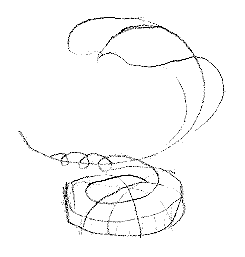| |
Armature for the manta ray
 To give the manta a good armature, I used a piece of fairly thick wire
for it's spine, as shown in the sketch on the right.
To give the manta a good armature, I used a piece of fairly thick wire
for it's spine, as shown in the sketch on the right.
Connect another piece of wire to the front end of the spine and
bend it round to the bottom end of the spine, but not too near the
end.
Make a base from a round piece of wood or the lid of a jar.
Roll another length of wire round the base end of the spine and
bend it into a circle. Place the circle onto the base. You can do this
with glue or nails, or by wrapping it with thin wire as I did.
Try to find a method you like best.
Just make sure it's secure on it's base.
 To finish your armature, take piece of tinfoil and wrap it carefully
round the wireframe. Flatten it and make sure its thick enough to
use as armature.
To finish your armature, take piece of tinfoil and wrap it carefully
round the wireframe. Flatten it and make sure its thick enough to
use as armature.
Use a balled up and flattened piece of tinfoil to create the belly
of the manta. This will help you later on when you're
applying the clay.
See the pictures in the introduction for size and
position of the belly.
Secure it with a large piece of tinfoil which you wrap around the
balled up piece.
 |
It might be easier to use mesh wire for the manta armature, but
I haven't yet worked with that myself. From the newsgroup I've heard it's
quite easy to use, but it's also expensive. |


|

 To give the manta a good armature, I used a piece of fairly thick wire
for it's spine, as shown in the sketch on the right.
To give the manta a good armature, I used a piece of fairly thick wire
for it's spine, as shown in the sketch on the right.
 To finish your armature, take piece of tinfoil and wrap it carefully
round the wireframe. Flatten it and make sure its thick enough to
use as armature.
To finish your armature, take piece of tinfoil and wrap it carefully
round the wireframe. Flatten it and make sure its thick enough to
use as armature.